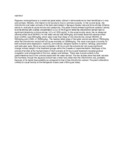| dc.description.abstract | Rapanea melanophloeos is a medicinal plant widely utilized in ethnomedicine to treat helmithiasis in man and animals. Hitherto, information on its toxicity to man or animals is scanty. In the current study, the chloroformic and water extracts of the bark were tested in Sprague Dawley rats and brine shrimp (Artemia salina) to evaluate its acute toxicity and cytotoxicity. The water extract showed significant cytotoxic activity to brine shrimp with a lethal concentration (LC50) of 59.37μg/ml while the chloroformic extract had no significant bioactivity on brine shrimp; (LC50 of 1250 μg/ml). In the acute toxicity study, the no observed adverse effect level (NOAEL) for the water extract was 300mg/kg and lowest observed adverse effect level (LOAEL) was 500mg/kg; which were lower than those of the chloroformic extract (NOAEL of 500mg/kg and LOAEL of 1000mg/kg). The median lethal dose of the water extract was above 7500mg/kg while the chloroformic extract did not cause mortality at 12500mg/kg. The most overt signs of toxicity for both extracts were depression, inactivity, somnolence, delayed reaction to stimuli, lethargy, piloerection and lackluster eyes. Recovery was complete in 48 hours and the extracts did not cause significant change in body weight in the treatment groups within the 2 weeks of experimentation. Necropsy of the animals that died at the highest doses of both extracts at 24 hours post treatment revealed general congestion and enlargement of the liver, spleen and kidneys. There was mucoid content in the gastrointestinal tract of the animals dosed with the water extract. The two studies show that both extracts are harmless, though the aqueous extract had a lower toxic dose than the chloroformic one, probably because of its higher bioavailability as compared to that of the chloroformic extract. The plant is therefore unlikely to cause toxicity at the therapeutic doses used (≈50mg per dose). | en_US |

